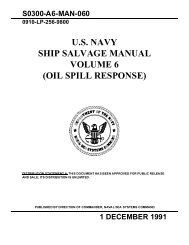June 2011 - Supervisor of Salvage and Diving
June 2011 - Supervisor of Salvage and Diving
June 2011 - Supervisor of Salvage and Diving
Create successful ePaper yourself
Turn your PDF publications into a flip-book with our unique Google optimized e-Paper software.
In public forums such as the Divers<br />
Working Group (DWG), fleet<br />
Divers have asked me how the <strong>Supervisor</strong><br />
<strong>of</strong> <strong>Salvage</strong> <strong>and</strong> <strong>Diving</strong> (SUPSALV)<br />
fits into the overall Navy salvage mission.<br />
Are our technical personnel <strong>and</strong><br />
the contractors we manage trying to take<br />
work away from the fleet The answer<br />
is no. Numbered Fleet comm<strong>and</strong>ers are<br />
responsible for the conduct <strong>of</strong> salvage<br />
operations in their respective theaters.<br />
If the required mission is within fleet<br />
capability (salvage in 300 fsw or less)<br />
fleet assets (primarily MDSU Divers<br />
<strong>and</strong> MSC salvage ships) do the work.<br />
Such has been the case multiple times in<br />
the last few years for major salvage evolutions<br />
(i.e. USS Hartford – USS New<br />
Orleans collision <strong>and</strong> harbor clearance<br />
<strong>and</strong> surveys in Port Au Prince, Haiti <strong>and</strong><br />
Talcahuano, Chile). It was true again<br />
during the recent port clearance operations<br />
in Japan following the devastating<br />
earthquake <strong>and</strong> subsequent tsunami that<br />
struck that nation on 11 March. The salvage<br />
work performed as part <strong>of</strong> Operation<br />
Tomodachi was h<strong>and</strong>led completely<br />
by fleet units. Specifically; MDSU ONE,<br />
EODMU FIVE, UCT TWO, COMLOG<br />
WESTPAC, <strong>and</strong> USNS SAFEGUARD.<br />
These comm<strong>and</strong>s surveyed <strong>and</strong> removed<br />
debris from three Japanese ports, thereby<br />
significantly improving the speed at<br />
which humanitarian supplies <strong>and</strong> fuel<br />
reached the Japanese people. They surveyed<br />
10,000 square meters <strong>of</strong> ocean<br />
bottom with side-scan sonar, logged 20<br />
hours in the water with remotely operated<br />
vehicles (ROVs) <strong>and</strong> 30 hours <strong>of</strong><br />
diving bottom time while removing 15<br />
tons <strong>of</strong> debris <strong>and</strong> marking other targets<br />
for future removal by Japanese commercial<br />
salvors. In a ddition to providing<br />
direct assistance to people in need, their<br />
work generated much good will with the<br />
Japanese government, an important U.S.<br />
ally. Everyone involved in this project is<br />
to be commended for a job well done.<br />
Engineering expertise, contractor<br />
access, <strong>and</strong> Emergency Ship <strong>Salvage</strong><br />
Material (ESSM) are resident in the<br />
Captain Patrick Keenan, USN<br />
<strong>Supervisor</strong> <strong>of</strong> <strong>Salvage</strong> <strong>and</strong> <strong>Diving</strong><br />
SUPSALV organization to augment fleet<br />
salvage forces, or perform specific missions<br />
that exceed fleet capability, such as<br />
open ocean search <strong>and</strong> recovery in depths<br />
greater than 300 feet. Current examples<br />
<strong>of</strong> this type <strong>of</strong> work are<br />
our mobilization <strong>of</strong> salvage<br />
pumps from ESSM<br />
bases in Sasebo, Japan<br />
<strong>and</strong> Singapore to assist<br />
with cooling damaged<br />
nuclear reactors at the<br />
Fukushima Daiichi facility,<br />
<strong>and</strong> deployment<br />
<strong>of</strong> search equipment onboard<br />
USNS CATAW-<br />
BA to locate an AV-8B<br />
Harrier that crashed in<br />
approximately 8,000<br />
fsw in the Gulf <strong>of</strong> Aden.<br />
The 300 foot operational<br />
navy diving<br />
depth limit that I<br />
mentioned in the first<br />
paragraph may change<br />
soon. In April, a Navy<br />
Experimental <strong>Diving</strong><br />
Unit (NEDU) – SUP-<br />
SALV team satisfactorily<br />
tested a new saturation fly-away<br />
diving system (SAT FADS) pier-side<br />
to 1,000 fsw. Six NEDU Divers were<br />
compressed to an equivalent dry<br />
depth <strong>of</strong> 1,000 feet, performed system<br />
checks at depth <strong>and</strong> then underwent<br />
ten days <strong>of</strong> saturation decompression.<br />
All went well. Our next challenge<br />
is to take SAT FADS to sea.<br />
The principal barrier to getting<br />
SAT FADS to sea is not technical, it is<br />
financial. The fiscal problems that our<br />
Navy <strong>and</strong> government now face are<br />
substantial <strong>and</strong> they will be with us for<br />
a long time. Funding for a seaborne test<br />
<strong>of</strong> SAT FADS has not yet been identified.<br />
Lack <strong>of</strong> funds is also the reason<br />
we have cancelled the <strong>2011</strong> Divers<br />
Working Group. While I certainly value<br />
meetings like DWG, we must make<br />
choices about our expenditures as budgets<br />
shrink. In this case it is clear, operations<br />
<strong>and</strong> direct fleet support come<br />
first. By not paying to hold a DWG,<br />
we will be able to continue to fund<br />
the diving system air testing program<br />
for the remainder <strong>of</strong> fiscal year <strong>2011</strong>.<br />
Keep diving!<br />
Post-tsunami port clearance operations in Japan conducted<br />
by U.S. Navy Divers aboard USNS Safeguard.<br />
<strong>June</strong> <strong>2011</strong> 3

















